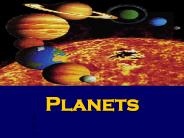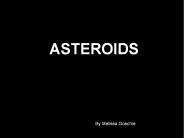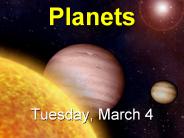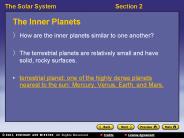Planets And Asteroids PowerPoint PPT Presentations
All Time
Recommended
Tunguska Event Siberia, 1908 June 30, 7:17 am Explosion of large meteorite at 6km altitude - deafening bangs and a fiery cloud With relevance to today, ...
| PowerPoint PPT presentation | free to download
Chapter 9 Asteroids, Comets, and Dwarf Planets Their Nature, Orbits, and Impacts 9.1 Asteroids and Meteorites Our goals for learning: Why is there an asteroid belt?
| PowerPoint PPT presentation | free to download
Title: Testing Author: Mark Voit Last modified by: Michael Brotherton Created Date: 9/29/1999 2:52:42 PM Document presentation format: On-screen Show (4:3)
| PowerPoint PPT presentation | free to download
Orbits of the Planets, Asteroids and Comets. Kepler's 1st Law tells us that. The orbits of the planets are ellipses. with the Sun at one focus. Sun. Perihelion, P ...
| PowerPoint PPT presentation | free to view
Heating of interior due to tidal stresses from Jupiter and other moons. Page 33 ... Jupiter's moon Europa: ice surface floating on underground ocean? Is there ...
| PowerPoint PPT presentation | free to view
Impact was 20 megatons Privately owned National Landmark. ... What are asteroids like? Asteroid Facts Asteroids are rocky leftovers of planet formation.
| PowerPoint PPT presentation | free to download
Only 2 documented cases in which a person is hit by a meteorite. Two documented Cases ... Capture of Comet Shoemaker by Jupiter. The Age of the Solar System ...
| PowerPoint PPT presentation | free to view
SOFIA Observations of Stellar Occultations, Extrasolar Planets, Asteroids, and Comets
| PowerPoint PPT presentation | free to view
Come up with a new mnemonic for the first eight planets. ( Prepare ahead of time) ... This will make your learning experience a better one. Page 51. Guidelines ...
| PowerPoint PPT presentation | free to view
Unique in that it appears to have undergone volcanism Two other Asteroids to know Pallas 580 km and Juno 540 km Asteroid Observations The Galileo space ...
| PowerPoint PPT presentation | free to view
Planets. By Dwayne J Johnson Jr. Solar System. The solar system is made up of the Sun, the 9 planets135 known moons, asteroids, ... The planet closest to the sun. ...
| PowerPoint PPT presentation | free to view
Modified by J. Tandean in July 2005 Original file created by Claude Pruneau
| PowerPoint PPT presentation | free to view
Planets Planets Definition Of A Planet An object in orbit around a star but does not give off its own light, Rather it shines by reflecting sunlight.
| PowerPoint PPT presentation | free to download
Definition Of A Planet. An object in orbit around a star but does not give ... Pluto - Pluto is a rocky planet that is usually the farthest planet from the Sun. ...
| PowerPoint PPT presentation | free to view
ASTEROIDS By Melissa Goschie What is an asteroid? Rocky-metallic objects Range in size from about the size of pebbles to around 600 miles (~1,000 km) across.
| PowerPoint PPT presentation | free to download
Studies of Pluto's surface show a long, narrow feature that has been ... Water would be frozen at Pluto's temperature, and we know of no extra heat sources. ...
| PowerPoint PPT presentation | free to view
For decades, Pluto was called the 'ninth planet'...though a very unusual planet. ... Are Pluto and Eris planets? International Astronomical Union definition of ' ...
| PowerPoint PPT presentation | free to download
This gas giant is the largest planet. Saturn - Saturn is the sixth planet from the Sun. This gas giant has large, beautiful rings. Uranus ...
| PowerPoint PPT presentation | free to download
Now about 30,000 asteroids have been discovered, 10,000 with. well defined orbits. ... Amor asteroids with perihelia between the orbits of Earth and Mars, ...
| PowerPoint PPT presentation | free to view
Asteroids range in size from about 1000 km down to the size of pebbles ... Impact would come on Friday the 13th in April 2029. Asteroid 2004 MN4 ...
| PowerPoint PPT presentation | free to view
Middle School level
| PowerPoint PPT presentation | free to download
Mars. Very very cold. Has two moons. Called the red planet. It's pieces hit earth. Jupiter ... Interesting Facts. Mercury and Venus only planets without moons ...
| PowerPoint PPT presentation | free to download
The Planets Discussing Planets Measure distances to planets in Astronomical Units (AU). 1 AU = distance from Earth to the Sun = 93 million miles.
| PowerPoint PPT presentation | free to view
The Planets The Solar System is made up of 8 planets, 3 dwarf planets (Pluto, Ceres and Xena) countless asteroids and comets. The sun is by far the dominant body in ...
| PowerPoint PPT presentation | free to view
2000 orbited 433 Eros for 1 year. Studied magnetic field, mass, orbit, composition & surface ... descent to surface of Eros. Images & data. Deep Space 1 ...
| PowerPoint PPT presentation | free to view
EROS orbital path. Gaspra orbital path. IDA orbital path. Mathilde orbital path ... http://neo.jpl.nasa.gov/cgi-bin/db_shm?sstr=EROS&group=ast&search=Search ...
| PowerPoint PPT presentation | free to view
Formation of Planets Accretion of dust in space due to GRAVITATIONAL FORCES Dust Asteroids Planets accretion of Heavy elements attraction of Light gases to dense nucleus
| PowerPoint PPT presentation | free to download
Planets are smaller than stars. ... How small can a ball of gas be and still qualify as a star? A star has nuclear fusion occurring in its interior. ...
| PowerPoint PPT presentation | free to download
... is the only planet that has life on it. On Earth you can find ... might have been liquid water and life on Mars, but nothing has been found to prove that yet. ...
| PowerPoint PPT presentation | free to view
... the asteroids are located between Mars and Jupiter which is an asteroid ... More interesting facts about asteroids. Very few asteroids ever make it to Earth. ...
| PowerPoint PPT presentation | free to view
Extrasolar Planets The first planet detected ... Rules of chemistry Observations of rock ... Asteroids Some asteroids appear to be rubble piles of broken ...
| PowerPoint PPT presentation | free to view
The Planets The planets, the planets, Oh yes, we are the planets. The planets, the planets Orbiting the sun. I m Mercury. I m Mercury, The closest to the sun.
| PowerPoint PPT presentation | free to view
Terms: The Planets Mercury Venus Earth Mars Pluto (Dwarf Planet Jupiter Saturn Uranus Neptune
| PowerPoint PPT presentation | free to download
The Planets M E R C U R Y N E P T U N E V E N U S E A R T H M A R S S A T U R N U R A N U S J U P I T E R * * * * * * COMETS Orbit Ion tail Dust tail COMETS Orbit Ion ...
| PowerPoint PPT presentation | free to view
Extrasolar planets
| PowerPoint PPT presentation | free to view
Fact: All major (currently observed) planets/moons/asteroids are revolving ... The number of collisions between objects depends on how many objects there are ...
| PowerPoint PPT presentation | free to download
Meteoroids! Asteroids! Comets! Oh, my! The devastation continues Poisonous gases and dust fills the atmosphere, blocks out the sun Temperatures drop drastically No ...
| PowerPoint PPT presentation | free to view
Mars. Mars has the most highly varied and interesting terrain of any of the planets. ... Choose one planet and create a paragraph about it using 4 facts you learned. ...
| PowerPoint PPT presentation | free to view
Our Solar System also has many moons, comets, asteroids, and dwarf planets(like Pluto). ... Click here to find out how many rings it has. Saturn has 31 known moons!
| PowerPoint PPT presentation | free to view
Terrestrial Planets
| PowerPoint PPT presentation | free to view
Saturn size. Neptune size. collisionless lifetime. Dynamics at low ... Mp Saturn. Larger masses also would leave structure in ring, and it is featureless ...
| PowerPoint PPT presentation | free to download
The Jovian Planets. Small Moons. Galilean Moons. Io. Volcanism on Io. Tidal Heating ... Medium-sized Moons of Saturn. Triton. Rings of Saturn. Ices In Saturn's Rings ...
| PowerPoint PPT presentation | free to download
The Outer planets By: Ian McGorray Kevin Bhasin Gnana Umpathy Dean Bizga The Outer Planets overview General Facts There is a very great distance between the inner and ...
| PowerPoint PPT presentation | free to download
Planets lists... List the planets in our solar system in order, starting with ... Mercury (closest to the sun) Venus, Earth, Mars, Jupiter, Saturn, Uranus, Neptune ...
| PowerPoint PPT presentation | free to download
The Planets. By. Mercury. Neptune. Venus. Pluto. Uranus. Earth. Mars. The Asteroid Belt. Jupiter. The Sun. Saturn. My favorite planet is _ because ...
| PowerPoint PPT presentation | free to view
Title: No Slide Title Author: Burkett, Kevin Last modified by: Burkett, Kevin Document presentation format: On-screen Show (4:3) Other titles: Arial Times Arial ...
| PowerPoint PPT presentation | free to download
Moons of Jupiter Jupiter has four large Galilean moons, twelve smaller named moons and twenty-three more recently discovered but not named moons. Saturn ...
| PowerPoint PPT presentation | free to download
Discovery of Extrasolar planets. Information from a graph of Doppler ... The first discovery, 51 Peg, had a 4 day orbit (0.05 AU!) and the mass of Jupiter. ...
| PowerPoint PPT presentation | free to view
The New (old) Planets So what do we do with Pluto? It is now classified as a Dwarf Planet along with Eris and Ceres (the asteroid). What is a Dwarf Planet?
| PowerPoint PPT presentation | free to download
Planets and Our Solar System. Our Solar System. Our sun is the center of our ... round asteroids such as Ceres and perhaps eventually Vesta, Pallas, and Hygeia. ...
| PowerPoint PPT presentation | free to view
Dinosaur fossils all lie below this layer. Iridium Layer Consequences of an Impact A meteorite 10 km in size would send large amounts of debris into the atmosphere.
| PowerPoint PPT presentation | free to download
The Terrestrial Planets Mercury Very hot/cold Difference between hottest spots and coldest spots is 600 Orbits the sun in 88 Earth days Rotates on its axis in 58 ...
| PowerPoint PPT presentation | free to download
Asteroids, Comets and Meteors Main objectives of this unit: Compare and contrast asteroids, comets and meteors. Distinguish between meteroids, meteors, and meteorites.
| PowerPoint PPT presentation | free to view
Tail also glows by the reflecting sunlight. It always points away from the solar winds ... The most popular comet. Orbits every 76 years. Halley's Comet. Asteroids ...
| PowerPoint PPT presentation | free to view
Lesson 4 Asteroids, Comets, and Meteoroids Asteroids Asteroids are rocky objects. Smaller than a planet. Found between Mars and Jupiter Weak Gravity No atmosphere ...
| PowerPoint PPT presentation | free to download
























































